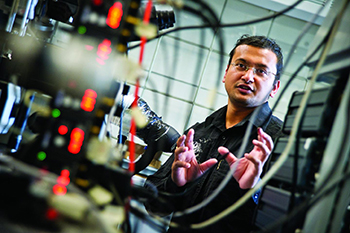
Samarendra Mohanty leads the biophysics and physiology lab at the University of Texas at Arlington. Credit: UT Arlington
A group from the University of Texas at Arlington, USA, has found a way, using a weakly focused near-infrared laser, to guide the growth of nerve cell axons—the long neural strands that carry signals out from the neuronal cell body—into loops of varying sizes (Sci. Reports, doi: 10.1038/srep06902). The researchers believe that this new method could help enable construction of 3-D neuronal structures, which could promote a better understanding of nerve activity in the brain.
Axonal “pathfinding” in the brain and peripheral nervous system is important for recovering nerve function after injury. If a damaged axon does not regrow along the proper path, the patient is at greater risk for abnormal neuronal circuit (synapse) formation, which can lead to nervous system dysfunction. Various chemical, electrical and even optical approaches to artificially guide axons in situ have been developed.
The Texas research team wanted to take one of those techniques—which uses a near-infrared laser signal, at a long working distance, to steer growth of the axon through repulsive cues—further, and see if the laser could nudge axons sufficiently strongly to form loops onto themselves, a phenomenon called “self-fasciculation.” Axons naturally avoid growing toward themselves and other axons; this self-avoidance is a proposed regulatory mechanism that controls proper synapse generation. Therefore, being able to force the axon to loop onto itself would means that the researchers’ non-invasive laser guidance method is strong enough to overcome an axon’s natural growth pattern.
To guide axon growth in vitro, the researchers applied the laser spot next to the axon. (No special effort was taken to tightly focus the beam at the sample plane.) An axonal turn of 20° within 20 minutes was considered a successful guidance event. Per these parameters, the researchers observed 100 percent effectiveness for turning events (n = 14). To ascertain if they could go beyond a 20° turn and create a loop (self-fasciculation), they repeatedly repositioned the laser spot until the axon circled on itself. These loops had significantly smaller radii than the few (1.5 percent) naturally occurring loops they observed in vitro.
This work builds on the lab’s previous research of near-infrared lasers to guide axon growth by pushing and pulling on the axonal growth cone. According to team lead Samarendra Mohanty, the study has “significant implications on the physical properties of axons.”
